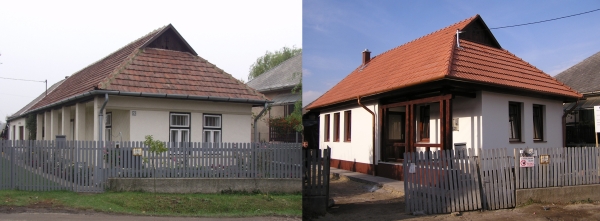Reconstruction in Felsőzsolca
Builders: architects from the Károly Kós Association and from Miskolc, university students
Text: Mihály Rudolf

Pintér Dániel mintaház terve
The emotional wounds caused by the flood disaster last year in Zsolca may never get healed. However, everyone living there could celebrate the Christmas of 2010 in a new house. This was partly owing to the generally selfless help of Hungarian architects. We should emphasize this now when the year of the election prioritizing political interests is over. Recognition should be expressed at last impartially. As in reoccurring emergency situations – designers shall see it independent of their social nexus – the design groups have been formed that could be relied upon when reconstructing. Now as we go to press the new year threatens this region with another flood and the soon ensuing extraordinary inland flood threatens almost half of the total area of Hungary: there is need for joining forces once again. (The editor)
A long phase of preparation, administration, intensive designing-constructing stage characterized the reconstruction in Felsőzsolca. Early summer last year flood hit the town more than once, in several waves. The last one – the worst hit – came on June 5th washing away many houses in the villages of Borsod-Abaúj-Zemplén county. In Felsőzsolca – beyond damaged infrastructure, roads, bridges, line networks and public buildings – more than 1800 cases of damage done to dwelling houses were reported. This is a large number compared to the total of 2,200 residential buildings in Zsolca. Of those houses built of adobe and/or cob walls 173 collapsed, and 28 real estates were rated as life-threatening ones. More than half of the damage done to the county was concentrated here, thus Zsolca had been treated specially by the flood.
Architects and itinerants of the Károly Kós Association – joined by university students and the professionals of two architects’ offices based in Miskolc – made survey on the spot in Felsőzsolca at 201 critically damaged real estates with the intention of designing new houses in line with the traditions of the village and suited for the actual sites instead of general and potential assistance in design. The regional plan of urban development made for Felsőzsolca in 2005 proposed 84 residential buildings for local protection. The projected salvage of values was based on a photo-documentation with details of the spatial and mass formation of the 84 houses concerned. Architects of the Károly Kós Association and Miskolc-based Hadas Studio used this cadastre for their first sketches and then also for the actual individual designs. Mányi Studio – helping the reconstruction after the flood in Bereg with several designs together with the Károly Kós Association – had similar ideas and updated their designs made nine years ago to suit the criteria of home designs typical of the Borsod region.
A total of 100 designs were submitted for the national tender by the deadline (July 15th, 2010), of which 50 were selected and qualified as proposed ones by the designated jury. In Felsőzsolca the Reconstruction Project Committee chose 22 (and then 16) from these 50 designs, adjusting to house designs of the local tradition, the construction of which was schedullable, adaptable and easy to realize. It was also necessary to do so because meanwhile negotiations with potential building contractors had to be launched. With regard to feasibility and also to avoid confusion, the contractors requested to have construction based on the least number of proposed designs possible. Among the 22 designs those by Dóm Építészműterem Ltd., DOP Architecture and Wéber Építész Iroda Ltd. were also included. Half of the 50 designs approved by the jury and all of the 16 selected designs were submitted by the Association, Mányi Studio or Hadas Studio. The last phase of selecting designers, which had been a procedure launched simultaneously with the tender itself, was about the selection of the victims of the disaster. Fifty clients had their houses built after 9 different designs made by 8 architects/duo of architects (Imre Balázs Arnóczki, Tibor Bata, Judit Gerencsér, Diána Mike, Mariann Nagy and Zoltán Lipták, Dániel Pintér, Tamás Rüll, László Zsigmond).
The flood caused devastating damage to buildings all over the village. The tragedy itself, the threatening and inexact reports by the media as well as a mistaken sentence uttered by László Sólyom president of the Hungarian Republic resulted in chaos and misunderstandings among town-dwellers who had been calm till then. As a result of elections, at the beginning of October every member of the board of representatives of the local government was replaced by new ones including the mayor. By the end of the year the commission of the author of this article as a chief architect was also terminated after six years. The new local government has not organized any kind of forum yet to discuss the anomalies of reconstruction, architectural and environmental issues also concerning the townscape and the lay-out plan.
The rapidity with which the job was done by building contractors is praiseworthy. It was a priority for them to keep themselves on the deadline dictated – not only with regard to invoicing, but also because of assistance. The new houses meant comfort for their dwellers. At Christmastime birth, new standards and light could move into their homes.




